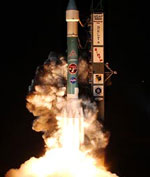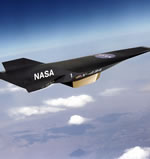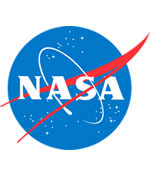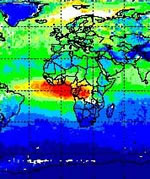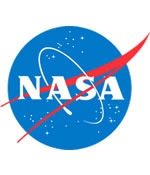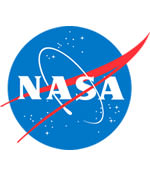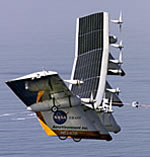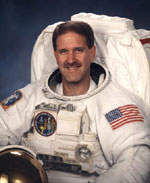
Image credit: NASA
NASA Administrator Sean O’Keefe announced today that astronaut Dr. John Grunsfeld would replace Dr. Shannon Lucid as the agency’s Chief Scientist. Grunsfeld is a veteran of four space shuttle flights, including two servicing missions to the Hubble Space Telescope and has studied astronomy and physics throughout his career. Lucid will return to the Johnson Space Center in Houston to assist with the shuttle’s return to flight activities.
Administrator Sean O’Keefe today announced the selection of veteran astronaut, astronomer, and astrophysicist Dr. John M. Grunsfeld as the agency’s new Chief Scientist at NASA Headquarters in Washington. He succeeds Dr. Shannon Lucid, effective immediately.
Grunsfeld, who played an integral role in two Space Shuttle servicing missions to the Hubble Space Telescope (HST), has studied astronomy and physics throughout his career. As NASA’s Chief Scientist, he’ll work to ensure the scientific merit of the agency’s programs.
“John has a deep interest in astronautical science and has the hands-on experience to back up what he has taught in the classroom,” said Administrator O’Keefe. “With his background in physics and astronomy, John is a natural selection to direct NASA’s important space-based science objectives.”
After serving nearly two years in Washington, Lucid will return to the NASA Johnson Space Center in Houston to assist the agency’s Return to Flight efforts. “I asked Shannon to come to Washington to help get our science priorities in order,” added Administrator O’Keefe. “Thanks to her leadership, and work with Mary Kicza, our Associate Administrator for Biological and Physical Research, our research goals have focus and a clear direction. Shannon’s insight and candor will be missed in Washington, but I’m sure her colleagues in Houston are looking forward to her return.”
She was selected as Chief Scientist in February 2002. During her tenure, one of Lucid’s most important tasks was to work with the offices of Biological and Physical Research, Earth Science, Space Science, and Space Flight to develop a comprehensive plan for prioritization of research on board the International Space Station.
Lucid also updated NASA’s science policy, which had not been done since 1996. The policy stipulates science grants will be peer reviewed, and NASA scientists must compete for research funding.
She joined NASA in 1978 and became an astronaut in August 1979. She has flown as a mission specialist on STS-51G in 1985, STS-34 in 1989, STS-43 in 1991 and STS-58 in 1993. In 1996, she was flown to Mir during STS-76, where she served as an engineer and conducted numerous life science and physical science experiments during her stay in orbit.
When Lucid returned to Earth after STS-79, she had traveled more than 75 million miles and spent more than 188 days in orbit, an American record at the time. For her extraordinary efforts, Lucid was awarded the Congressional Space Medal of Honor.
Grunsfeld is a veteran of four Space Shuttle flights. In1999 and 2002 he took part in a total of five successful spacewalks to upgrade Hubble. As a Mission Specialist on STS-103, Grunsfeld helped install new gyroscopes and scientific instruments and upgraded Hubble’s systems. During STS-109, he served as Payload Commander, in charge of the spacewalking activities and the HST payload. He and three other crewmates installed a new digital camera, cooling system for the infrared camera, new solar arrays, and power system.
“Servicing the Hubble Space Telescope is by far and away the most meaningful thing I’ve ever done. It’s helping us answer fundamental questions about our world and our place in the universe,” said Grunsfeld. “I was born the same year NASA was established, so we grew up together. I quickly discovered space exploration and science mesh well together and I couldn’t be more excited about this opportunity.”
A native of Chicago, Grunsfeld received a bachelor’s degree in physics from the Massachusetts Institute of Technology in 1980. He earned a masters degree and a doctorate in physics from the University of Chicago in 1984 and 1988, respectively.
Grunsfeld was selected as a NASA astronaut in 1992. His first flight assignment came in 1995 on board the Space Shuttle Endeavour on STS-67. In 1997, Grunsfeld served as flight engineer for the Space Shuttle Atlantis during STS-81 and a 10-day mission to Russia’s Mir space station. He has logged over 45 days in space, including 37 hours and 32 minutes working outside the Space Shuttle.
Grunsfeld has been honored with the W.D. Grainger Fellow in Experimental Physics and was awarded the NASA Distinguished Service Medal earlier this year. He was awarded NASA Space Flight Medals in 1995, 1997, 1999, and 2002, and earned the agency’s Exceptional Service Medal in 1997, 1998, and 2000.
Source: NASA Press Release

